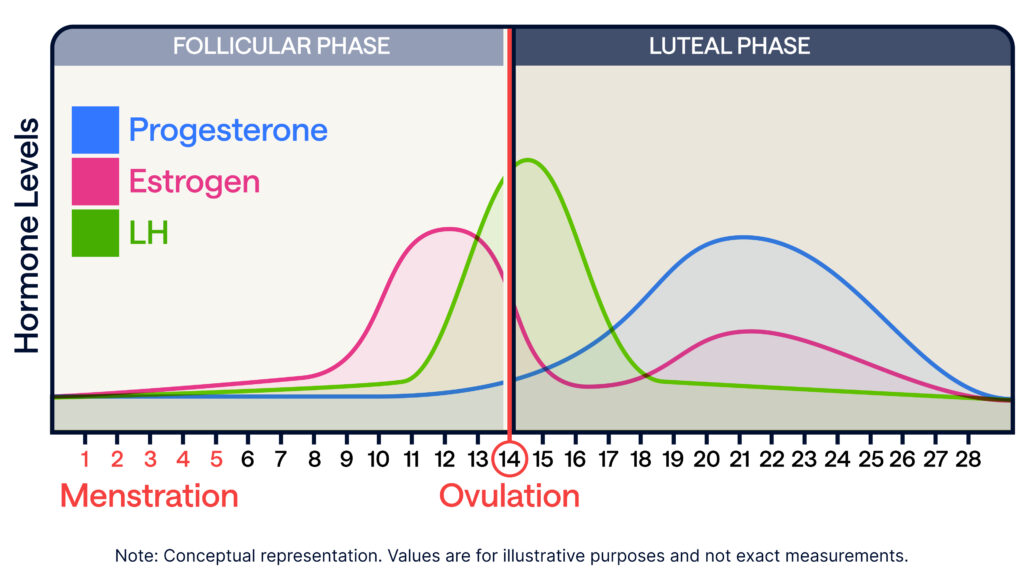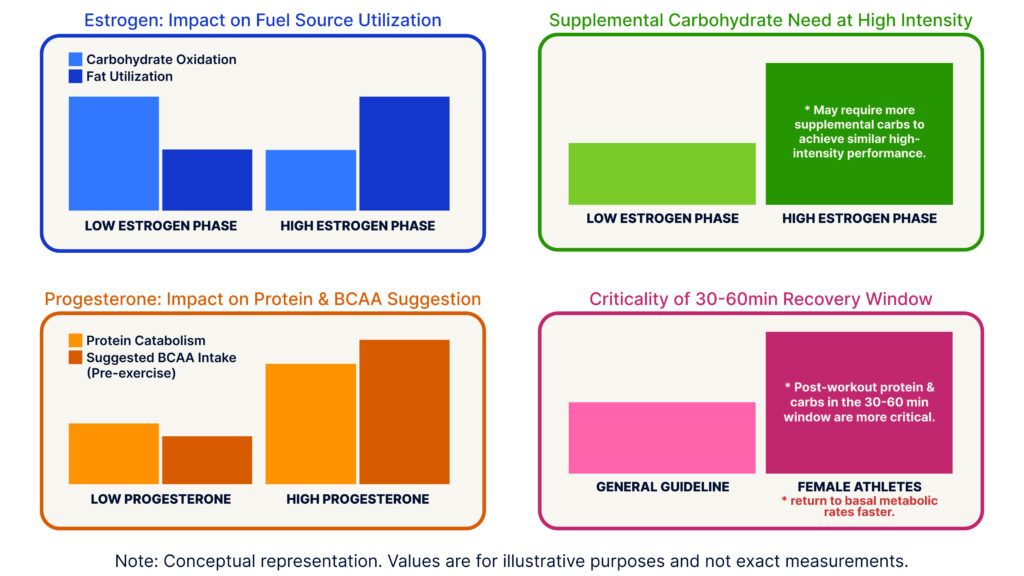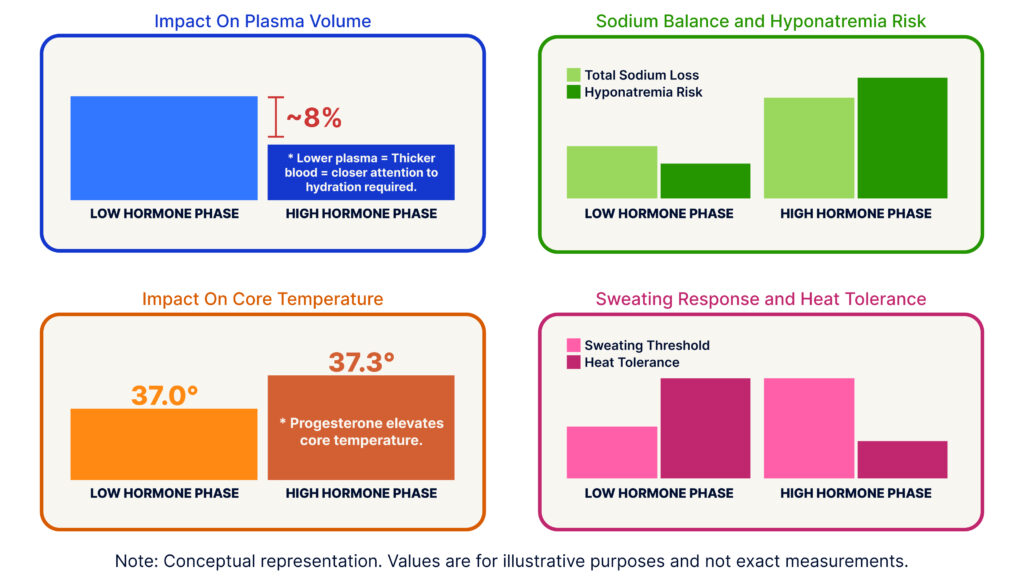For the female athlete seeking peak performance, understanding how the hormones of their monthly cycle affect performance is important. Because the human body is complex and research on this topic is still relatively new, for this article we’re going to keep it simple. If you want to get into more details, check out the references linked at the end of this article.
The Menstrual Cycle
Assuming a typical 28 day cycle, we break the cycle into two 14-day phases, the follicular phase (day 1-14) and the luteal phase (day 15-28). Day 1 of the cycle is when menstrual bleeding starts. There are two main hormones involved, estrogen and progesterone. At about day 5 or 6, estrogen (produced in the ovaries) rises slightly. Around day 12 there is a surge in estrogen coupled with a luteinizing hormone (LH) surge, which causes ovulation. Estrogen levels decrease somewhat after this but will soon rise again.
Upon ovulation, progesterone levels increase to prepare the lining of the uterus for egg implantation. This is the luteal phase and the high hormone phase. The highest hormone levels of both estrogen and progesterone occur about 5 days before the period. This is often the time on the cycle where women may experience premenstrual symptoms. If there is no egg implanted, progesterone levels fall and we shed the lining and are back to day 1.

If you wear a Garmin watch and track your period using Garmin Connect, you have the option to make your menstruation phase (starting Day 1) visible in TrainingPeaks. Click here to learn how to sync your Garmin period tracking data to TrainingPeaks so that you can easily see how your period coincides with your training and racing schedule.
What Does This Mean for Endurance Athletes?
Hormone levels play a role in our substrate (carbohydrate, fat, and protein) metabolism, plasma volume levels, and how we deal with heat stress (thermoregulation). Note: there are quite a few additional hormones that are involved in these processes, but for simplicity we are just focusing on the two primary female sex hormones.
We’ll keep it simple by calling the luteal phase, especially the mid-luteal, the high hormone phase. The follicular phase, especially the beginning, is a low hormone phase.
Metabolism
Estrogen is known to reduce carbohydrate oxidation and increase free fatty acid availability. This means when estrogen levels are high, women tend to conserve glycogen stores and utilize more fat as fuel. For longer endurance events (ultramarathons as an example) this could potentially be beneficial. But this glycogen sparing mode might make it more challenging to reach higher intensities. Supplemental carbohydrates are important in this phase. In other words, if you are in a high hormone phase, you might find you need to take in a few extra carbohydrates to get a similar higher intensity performance as you would without supplemental carbohydrates in a low hormone phase, assuming all other conditions are equal. On race day, this is important.
Progesterone promotes protein catabolism, and Stacy Sims, Research Scientist and founder of OSMO Nutrition, suggests ingesting BCAAs pre-exercise during the mid-luteal/high hormone phase. Protein ingestion is also important for female athletes in regards to recovery. The recovery window is a lot tighter for women, as we return to basal metabolic rates within a few hours. For harder efforts or training of long duration, that 30-60 minute window to consume post-workout protein and carbohydrate is a lot more critical for women.

Fluids and Thermoregulation
The hormones are also an important player in plasma volume regulation. Plasma volume is basically the volume of fluid in our blood. Our fluid volume in relation to solutes (ie sodium, potassium) is important. When hormones are high, the estrogen and progesterone cause a drop in plasma volume by about 8%, so think thicker blood. Improved endurance performance typically comes with higher plasma volumes, so we have to pay closer attention to hydration in this phase. Women are more predisposed to hyponatremia during the this phase as well because progesterone increases total body sodium losses.
Additionally in the high hormone phase, core temperature is slightly elevated thanks to progesterone. Sweating is initiated at a higher core temperature, and thresholds to initiate vasodilation to help shed heat is altered. This means heat tolerance is reduced in the high hormone phase, which could lead to earlier fatigue. This effect could potentially be mitigated with heat acclimatization and adequate fluid intake.

Effects of Oral Contraceptives
Oral contraceptives increase hormone levels significantly, and you can consider yourself always in a high hormone phase. Even during the placebo week, natural estrogen surges up to concentrations to mimic the natural luteal phase.
Monitoring Your Response
As you train through several cycles leading up to your event, pay attention to how your body responds to training and your hormone fluctuations. Everyone is a little different, so it’s a good idea to keep a record of how you are responding. Using TrainingPeaks metrics and tracking your Training Stress Balance (TSB) is a good way to track how you feel and what might correlate to your cycle.
Race Day Issues
For optimal race performance women want to be in a low hormone phase. This could be just prior to menstruation or the very start of menstruation, and some studies have shown improved performance here. However, menstrual bleeding can be very inconvenient during a race, especially one of longer duration. Additionally, premenstrual symptoms that may occur (irritability, bloating) can make for an non-ideal state, both mentally and physically.
If you happen to race during menstrual bleeding, be prepared. If you are doing an Ironman race, consider placing feminine products in your special needs bags. For the half-ironman distance or a marathon you might use a product designed for a slightly heavier flow. For events like a century ride, your jersey pockets can help you bring extra protection along.
Some athletes will modulate their menstrual cycles through the use of oral contraceptives so they can prevent bleeding on race day. If you choose this route, consult with your doctor first and remember you will be in a high hormone phase during the race.
In summary, understanding how the hormonal changes of your cycle impacts your physiology can help you better structure your training and be better prepared for racing.
The author would like to thank Stacy Sims, PhD. for her contributions to this article.
References
Sims, S. (2019, September 23). Women are Not Small Men: a paradigm shift in the science of nutrition [Video]. TEDxTauranga. Retrieved from https://www.youtube.com/watch?v=e5LYGzKUPlE
Lebrun, C.M. et al. (2020, February 27). Effects of Female Reproductive Hormones on Sports Performance. Retrieved from https://link.springer.com/chapter/10.1007/978-3-030-33376-8_16
Hausswirth, C. & Le Meur, Y. (2011, October 1). Physiological and Nutritional Aspects of Post-Exercise Recovery, Specific Recommendations for Female Athletes. Retrieved from https://pubmed.ncbi.nlm.nih.gov/21923203/




